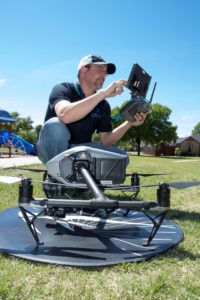The Federal Aviation Administration (FAA) expects the number of drones in our airspace to increase as much as threefold by 2023, as commercial drone operations become more common. But with more drones in the air, mishaps become more likely. In 2017, the FAA reported an average of 250 safety incidents per month, in some cases halting operations at major international airports.
 Israeli startup Vorpal specializes in tracking and, ideally, preventing those near misses. Their drone detection and tracking solution, VigilAir, uses a geographically distributed network of sensors that scan relevant frequencies to identify drone transmissions, allowing them to identify and track drones and their operators in near-real time.
Israeli startup Vorpal specializes in tracking and, ideally, preventing those near misses. Their drone detection and tracking solution, VigilAir, uses a geographically distributed network of sensors that scan relevant frequencies to identify drone transmissions, allowing them to identify and track drones and their operators in near-real time.
Each of Vorpal’s sensors is equipped with computing hardware that processes their location-tracking software. The more drones in the sky, the more compute power needed to handle all that data. To ensure that VigilAir can seamlessly maintain those capabilities, Vorpal is looking to the cloud, working with AT&T and Microsoft to test how edge computing could allow them to track thousands of drones at any given time.
The AT&T Foundry, a network of innovation spaces dedicated to rapid prototyping, is testing how to bring network edge compute (NEC) capabilities into AT&T’s network with Microsoft’s intelligent edge offerings, including Azure’s IoT and AI services, and Azure Stack hybrid technology. By deploying Microsoft’s advanced cloud services closer to the edge of the network, NEC could allow businesses to access low-latency network compute at a fraction of the cost of traditional, embedded processing.
Learn more about the proof-of-concept solution Vorpal is developing with AT&T and Microsoft.
